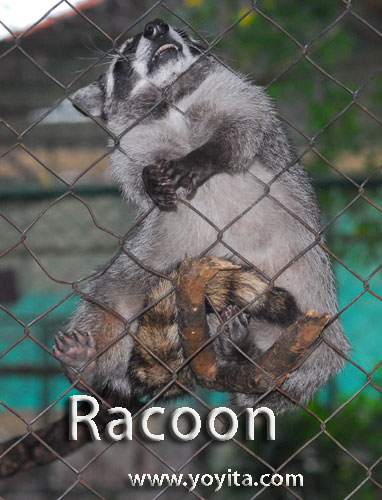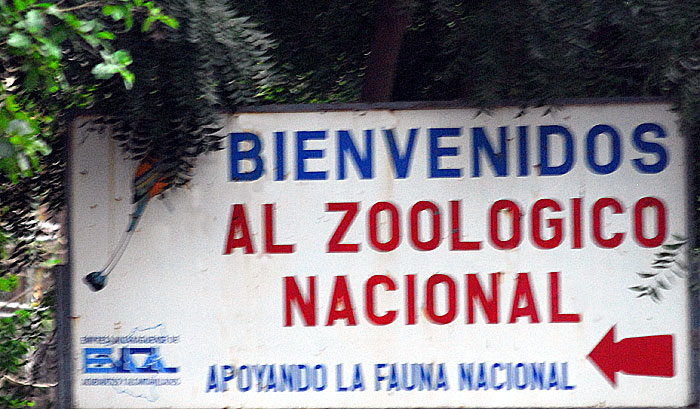Raccoons
Scientific classification
Kingdom: Animalia
Phylum: Chordata
Class: Mammalia
Order: Carnivora
Family: Procyonidae
Genus: Procyon
Storr, 1780
A raccoon (also spelled racoon) is a nocturnal mammal in the genus Procyon of the Procyonidae family. Raccoons are unusual for their thumbs, which (though not opposable) enable them to open many closed containers (such as garbage cans) and doors. They are omnivores with a reputation for being clever and mischievous; their intelligence and dexterity equip them to survive in a wide range of environments and in the presence of humans. Raccoons range from 50 to 100 cm in length (including the tail) and weigh between 4.5 and 16 kg. The raccoon's tail ranges from 20 to 40 cm in length. Male raccoons are generally larger than females. A baby raccoon is called a kit[1]. Raccoon hindfeet are plantigrade (flat-footed) similar to a human's.
Species
There are three species of raccoon. The most widespread is the Common Raccoon (P. lotor), which is also known as the Northern Raccoon or the Mapache, has a natural range of Southern Canada to South America, and has been introduced to Continental Europe. Raccoons can live in the city or in the wild, and while they are not domesticated they are on rare occasion kept as pets.
The two rarer species are the Tres Marias Raccoon (P. insularis), native to the Tres Mar�as islands off the Pacific Coast of Mexico, and the Crab-eating Raccoon (P. cancrivorus) of the tropics. The word "raccoon" is derived from the Algonquian word aroughcoune, "he who scratches with his hands." The genus name, Procyon, comes from the Greek for "pre-dog"; this term is also used for the star Procyon.
Some raccoons once considered separate species are now thought to be the same as or subspecies of the common raccoon, including the Barbados Raccoon (P. gloveralleni), Nassau Raccoon (P. maynardi), Guadeloupe Raccoon (P. minor), and Cozumel Island Raccoon (P. pygmaeus) (Helgen and Wilson 2005).
Raccoons are nocturnal and omnivorous, eating berries, insects, eggs and small animals. Raccoons sometimes wash, or douse, their food in water before eating it. It is unknown why raccoons perform dousing, but cleaning food is unlikely to be the reason. Studies have found that raccoons engage in dousing motions when water is unavailable; researchers note that captive raccoons are more likely than wild raccoons to douse food. It has been suggested that captive raccoons are mimicking fishing and shellfish-foraging behaviors. It may also be that the raccoon is searching for unwanted material, as water is thought to heighten their sense of touch.
Raccoons as pets
In most states of the United States it is illegal to keep raccoons as pets, because of rabies. Some states allow the practice, but require exotic pet permits[9]. Young orphan wild raccoons may carry rabies. Domesticated raccoons acquired from reputable breeders may make suitable pets; however, raccoons are not domesticated animals. Training raccoons is an intensive and ongoing process, and captive raccoons may retain destructive or aggressive natural behaviors, such as biting. Some douse their food in or defecate into the water dishes of other pets. Although nocturnal, captive raccoons can be trained to sleep at night and to be active during the day.
Captive raccoons can develop obesity and other disorders due to unnatural diet and lack of exercise; furthermore, many veterinarians will not treat raccoons. Raccoons raised in captivity and released do not adapt well to life outside.
Raccoons as food
Raccoons were a source of food for early American pioneers, providing a sizeable amount of protein. "Coon" hunts and cuisine can still be found in regions of the southern United States. The fat is strongly flavored and has a disagreeable odor, so it is generally removed before cooking. The favored method of cooking is roasting, with recipes suggesting that sweet potatoes are a good complement to the raccoon's meat, which is dark, as either a stuffing or side dish. |



